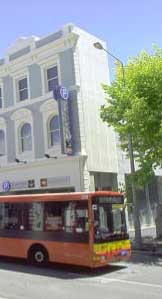| Our Environment: Issue 27 Winter 2001 |
A “big red” heads towards the inner city Bus Exchange at 8am on a freezing Monday morning. Inside the centre, the real-time electronic screen indicates that the Merrin (via University) bus is about to arrive at platform B1. Passengers, mostly students, leave their seats in the warm waiting lounge and queue near the door. Within two minutes they have all boarded and are en route to Ilam.
Meanwhile, the screen shows that the Redcliffs bus is three minutes away and the Templeton and Brighton buses will arrive at their designated platforms in four minutes. Each arrival is announced twice over the speaker system. Apart from platform doors not opening later in the morning due to one driver not lining up his bus correctly, everything is running smoothly. Bus drivers and passengers appear quite at home with the system that only became fully operational on 1 April this year. The revolutionary bus system required changes in bus routes and four new peripheral terminals -where buses start and end their journey -as well as the state-of-the-art exchange in The Crossing. “Generally it’s operating very well, “ says Dave Hinman, Central City Policy Leader at the City Council. “Many passengers have made positive comments about the high quality of the lounges and easy access to buses.”
 Buses using the nine internal stops
enter and depart from Lichfield Street. Passengers waiting for buses at the other six
stops on either side of Colombo Street can still wait in the exchange, which has entrances
off all three streets bounding it. “With the real-time information system, people
have quickly become used to watching for their bus on the screen and listening to
announcements of bus arrivals,” Dave Hinman says. The exchange’s proximity to
shops and other facilities is a plus for many passengers, and local businesses have
reported an increase in business since the opening of the facilities. The introduction of
more super-low buses has boosted the service’s image.
Buses using the nine internal stops
enter and depart from Lichfield Street. Passengers waiting for buses at the other six
stops on either side of Colombo Street can still wait in the exchange, which has entrances
off all three streets bounding it. “With the real-time information system, people
have quickly become used to watching for their bus on the screen and listening to
announcements of bus arrivals,” Dave Hinman says. The exchange’s proximity to
shops and other facilities is a plus for many passengers, and local businesses have
reported an increase in business since the opening of the facilities. The introduction of
more super-low buses has boosted the service’s image.
However, there have been complaints about the increased number of buses using Colombo Street and passing though Cathedral Square – the result of the peripheral terminal system. The Riverside terminal at the corner of Rolleston Avenue and Cashel Street is overloaded and this is impacting on the residential and cultural area, according to residents. On the other hand the new routes mean that Christchurch Hospital is now accessible for more people.
“We’re looking at providing some further stops, other than in Rolleston Avenue, and ultimately relocating some routes away from there,” says Dave Hinman. “More through-routing, relocation to other peripheral terminals and the restoration of two way traffic in Lichfield Street would allow the hospital terminal to be on the other side of the river.”
Passengers milling beside the Colombo Street stops causes crowding at peak times but this should be partly alleviated by seating in the ramp area leading into the covered part of the exchange. Dave Hinman says the City Council and Environment Canterbury will continue to introduce improvements aimed at weaning more people off their cars and onto the buses.
In the last financial year ending 30 June, city buses carried about 10.5 million passengers, 9.5 per cent more than the previous year. Now that the new system is up and running Environment Canterbury and the City Council hope to at least equal this growth rate this year.
Jennie Hamilton
| Our Environment Index |